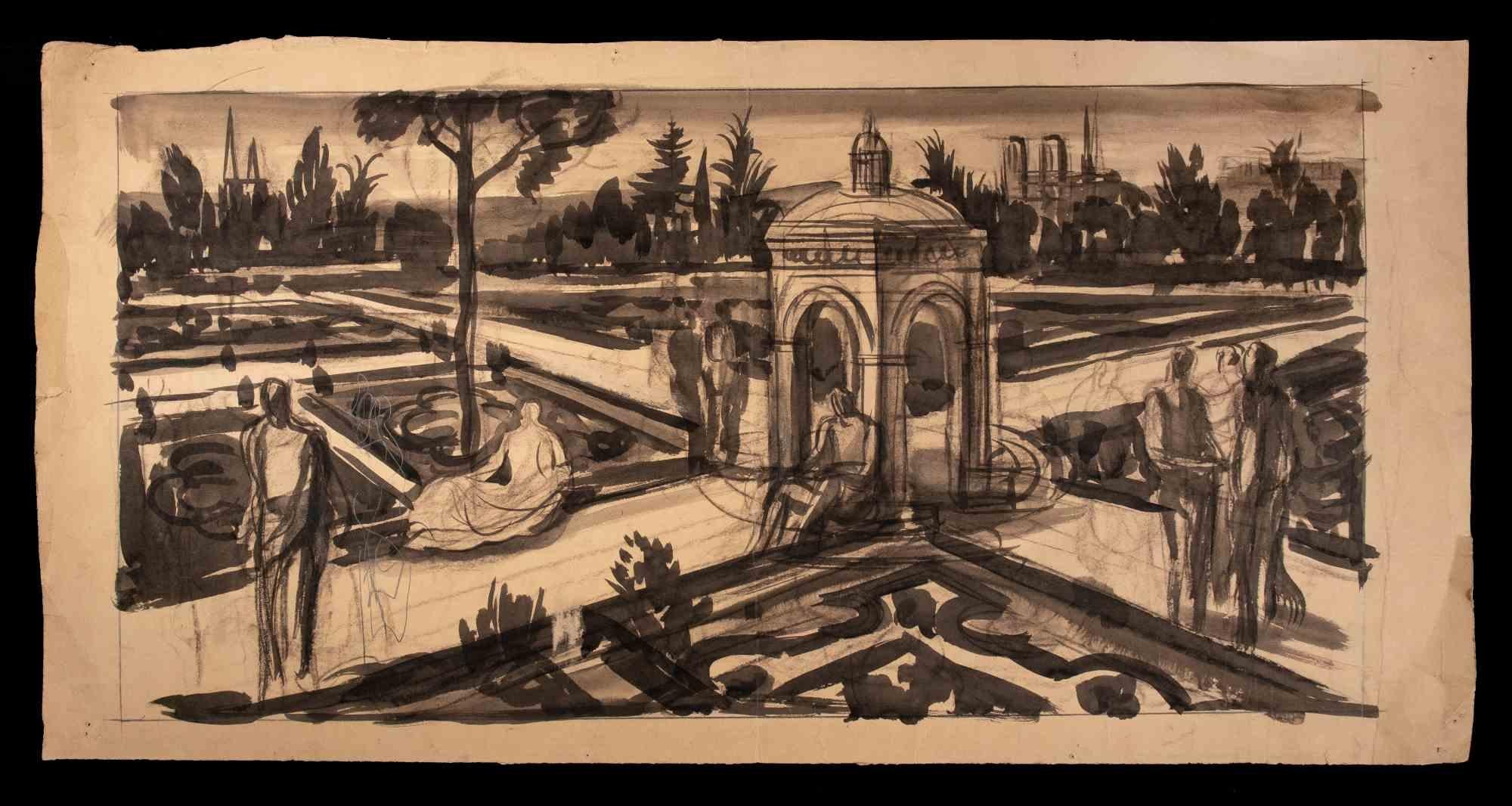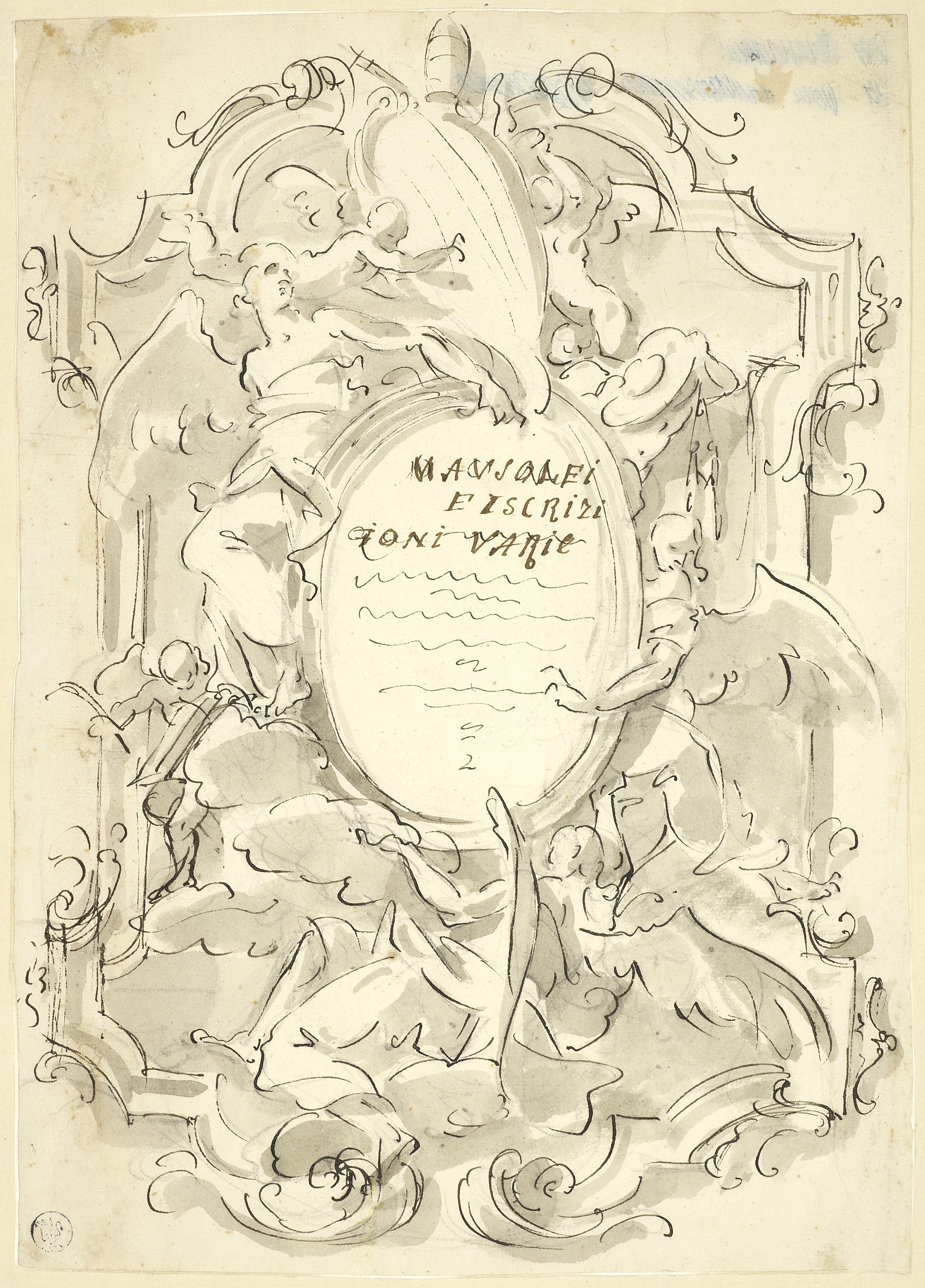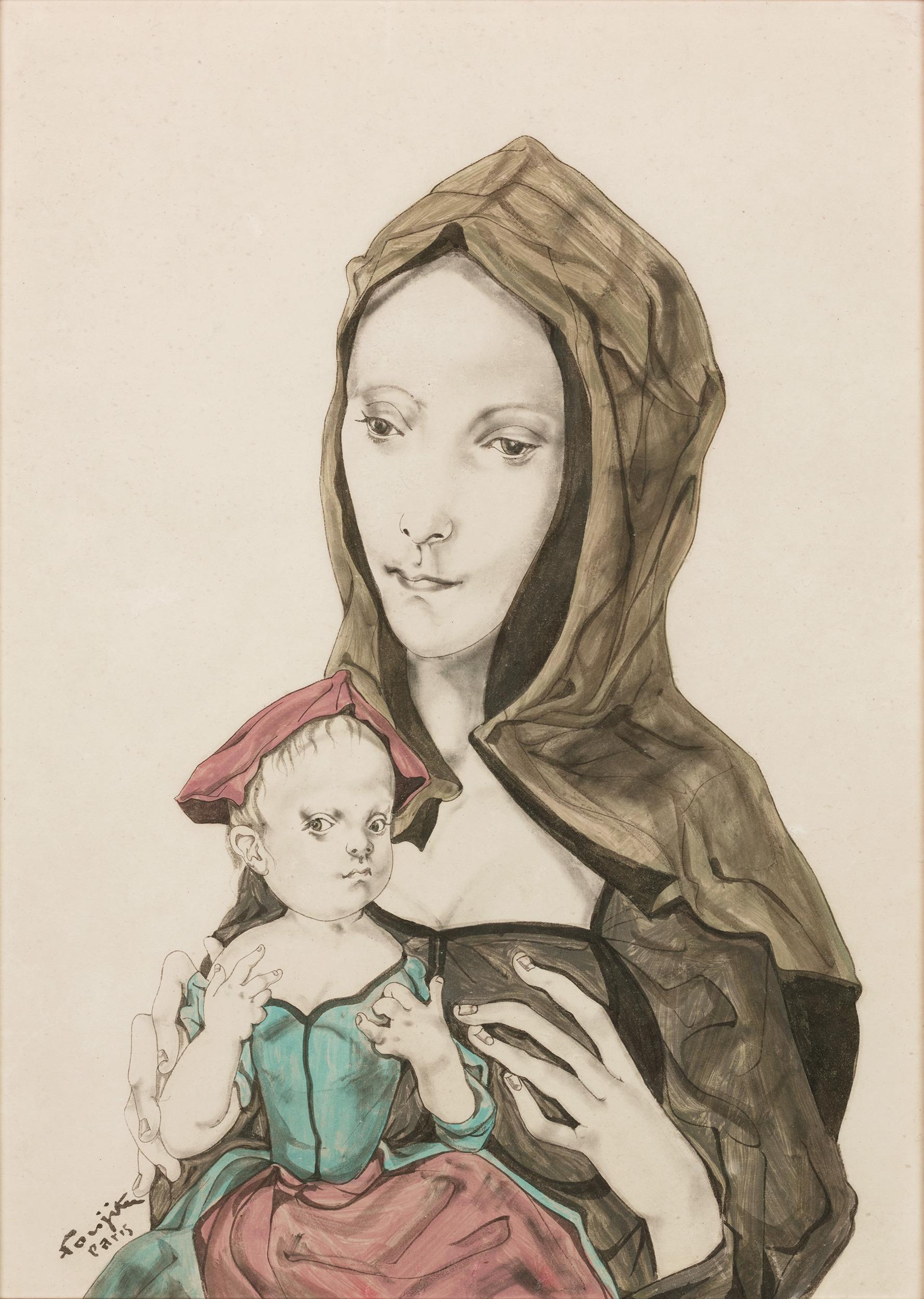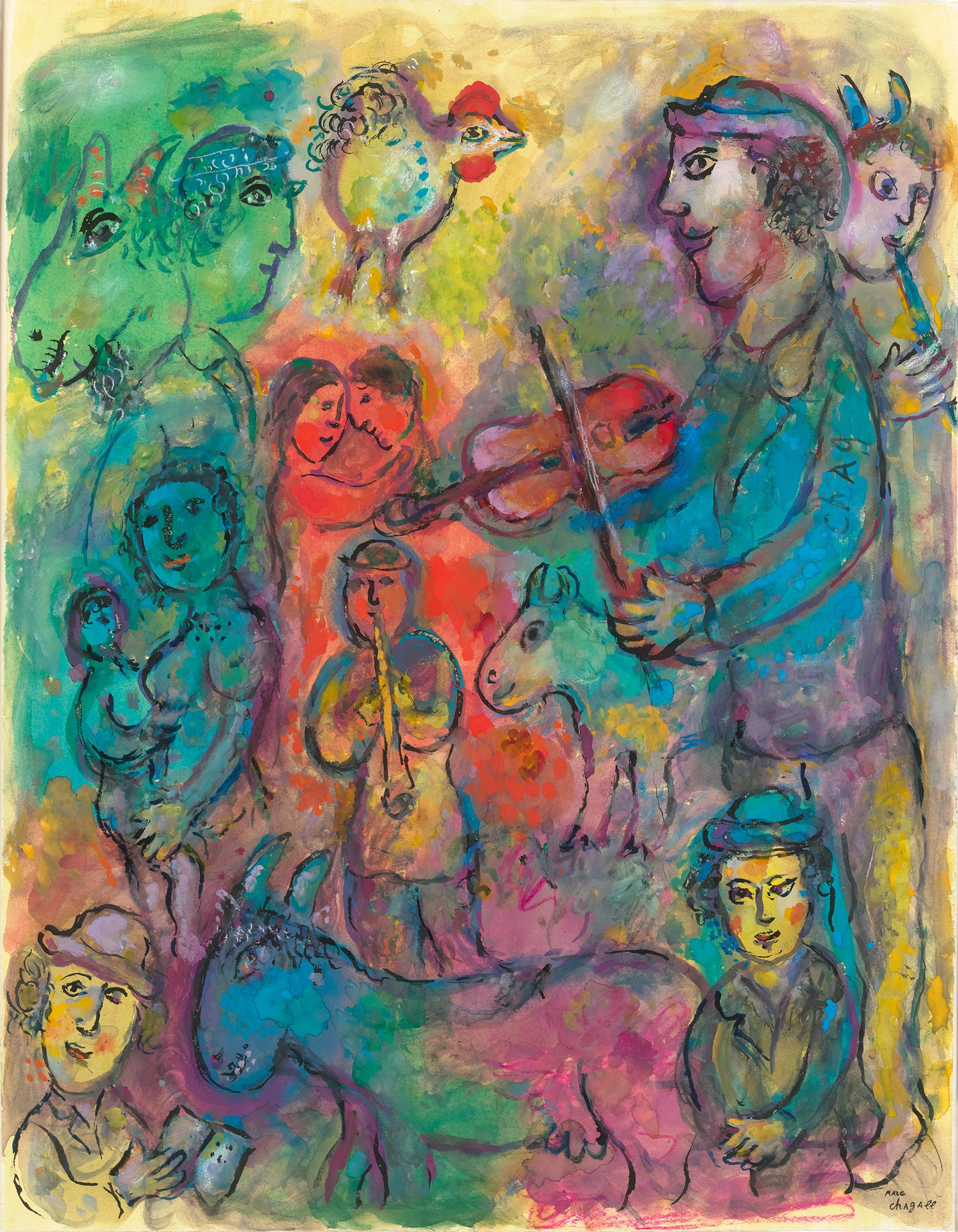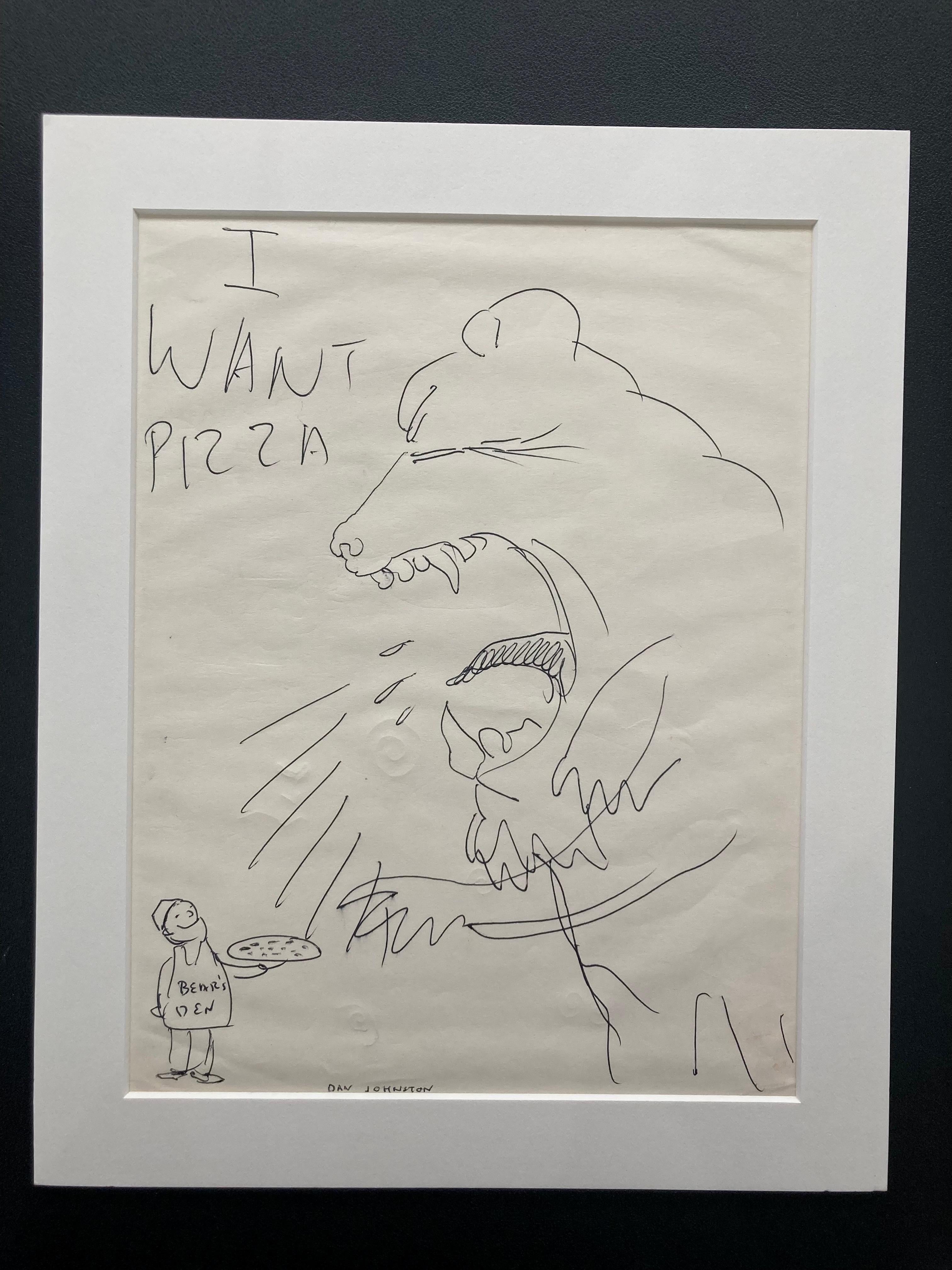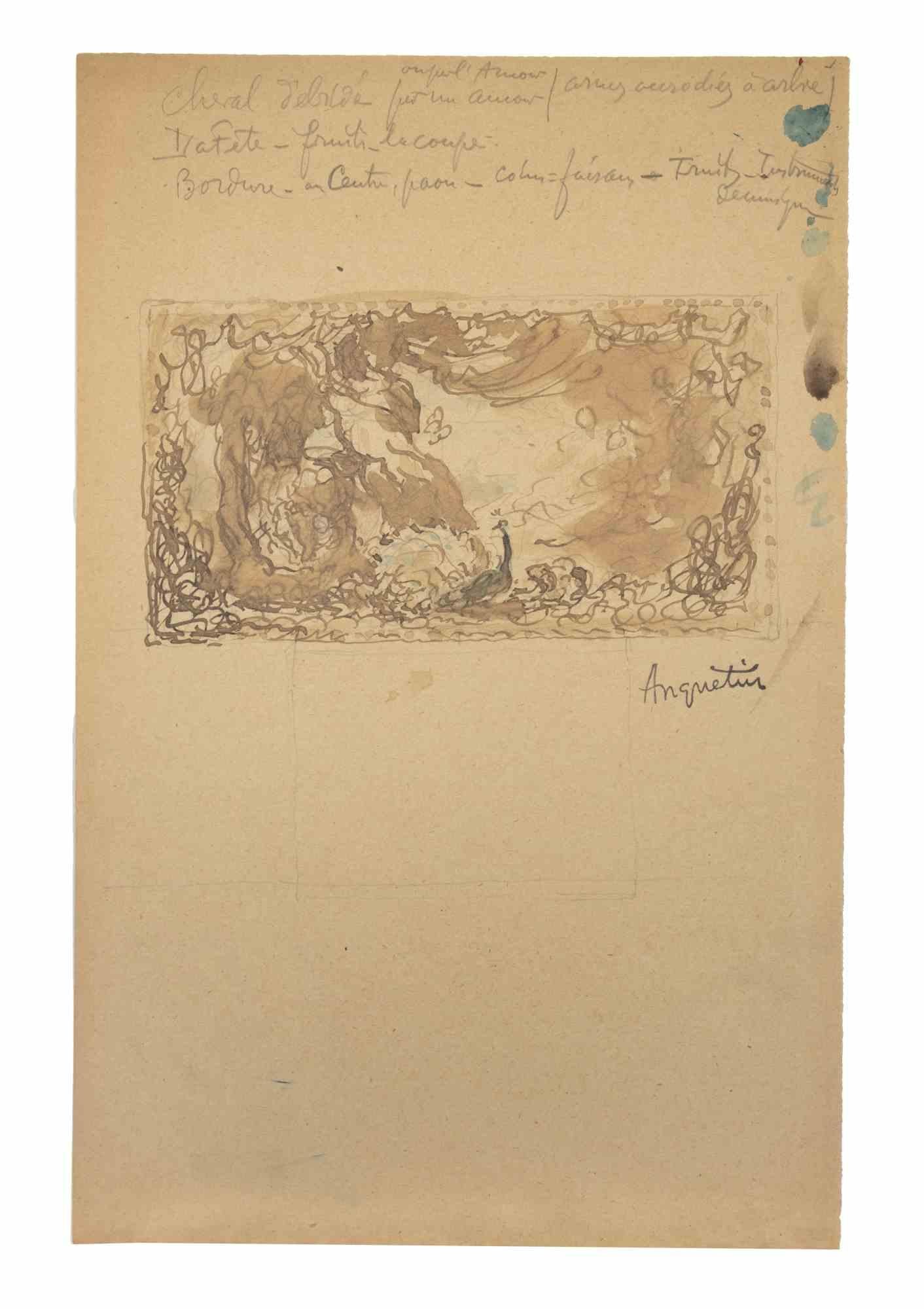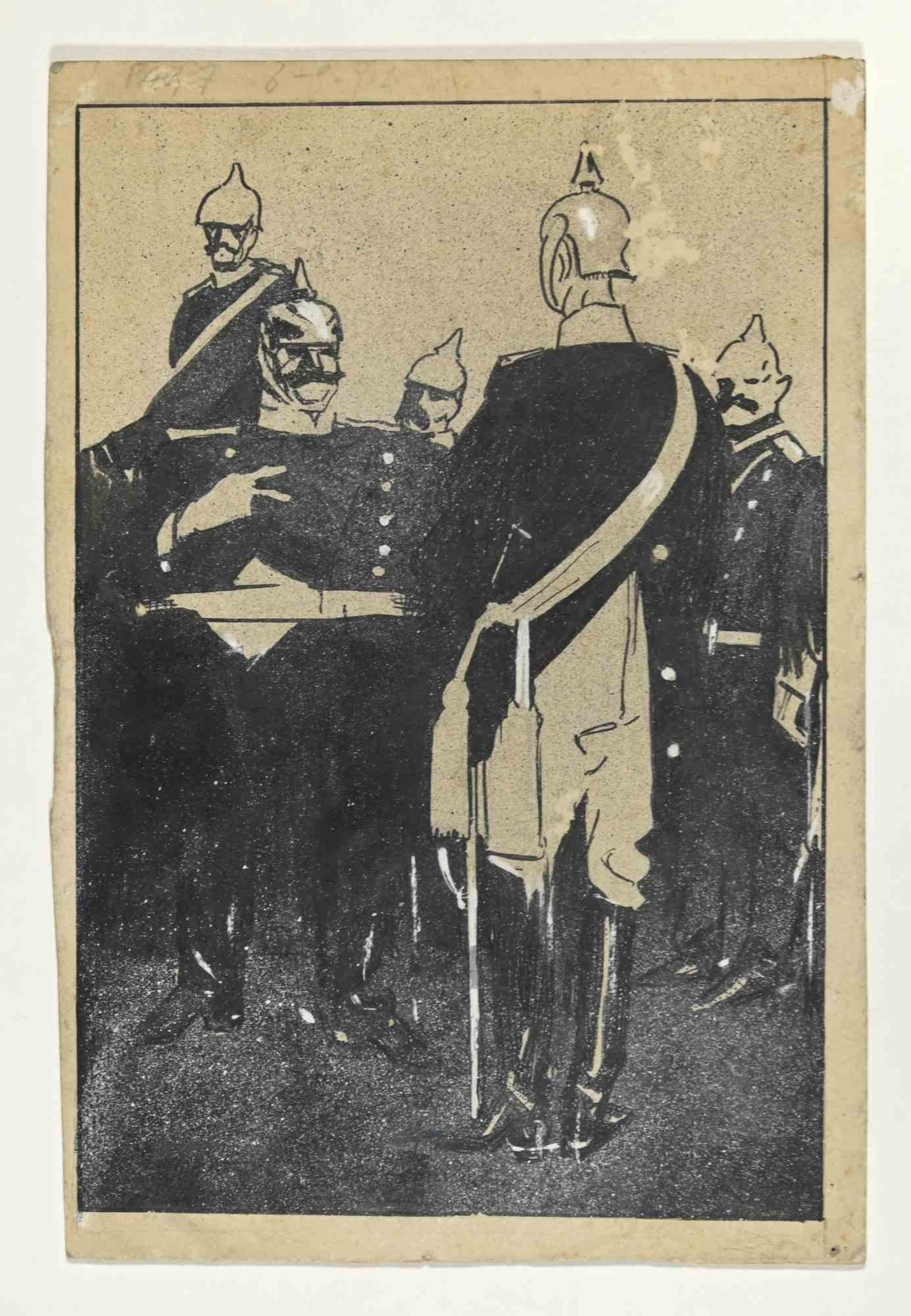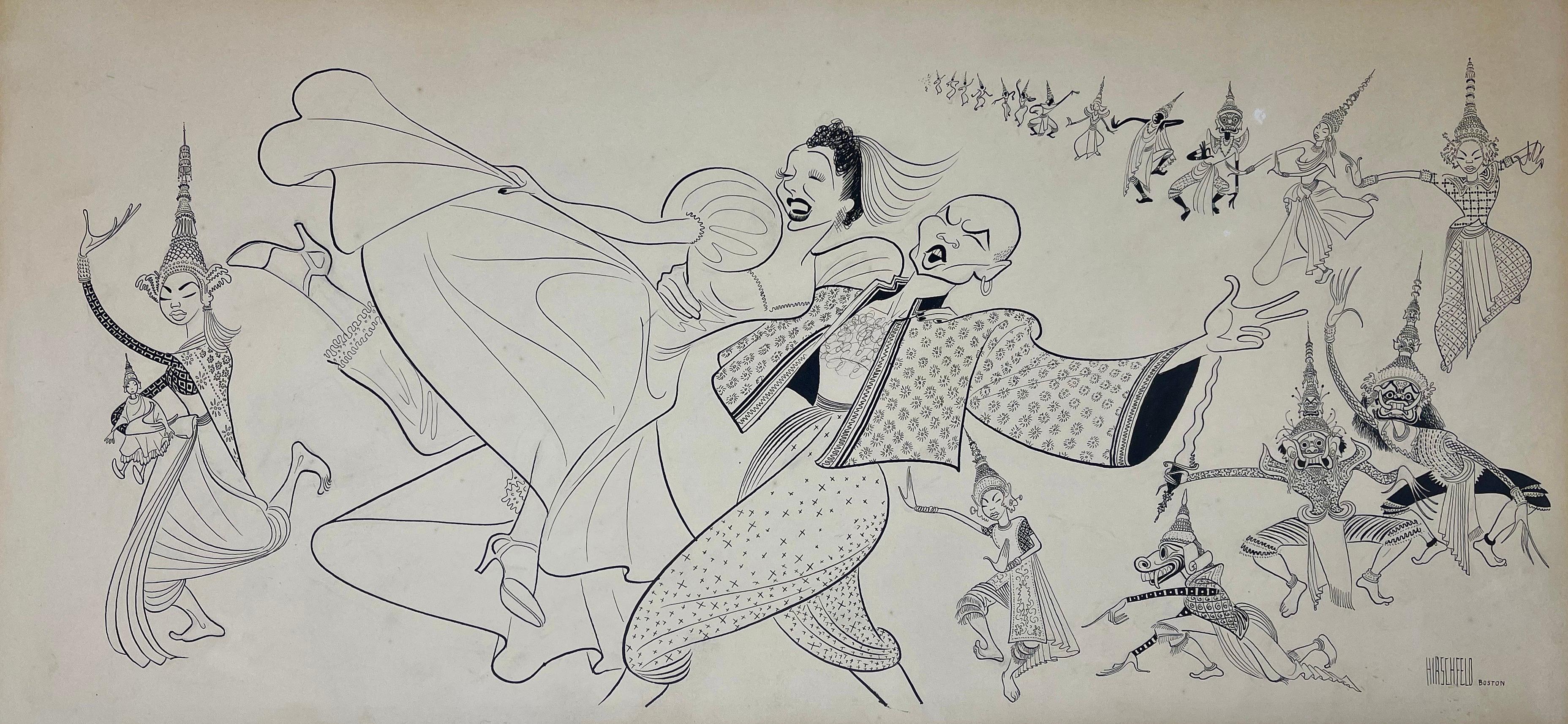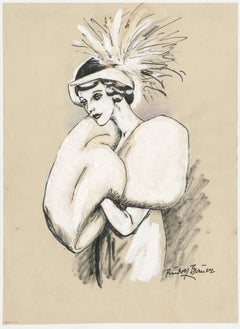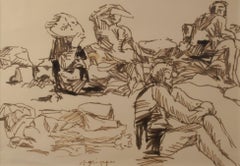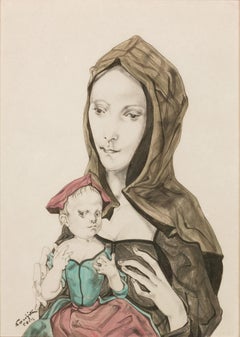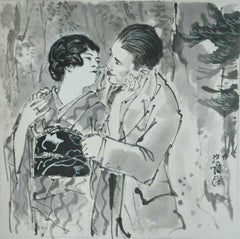
Couple Embracing
View Similar Items
Want more images or videos?
Request additional images or videos from the seller
1 of 5
Ito ShinsuiCouple Embracingc. 1928
c. 1928
About the Item
- Creator:Ito Shinsui (1898 - 1972, Japanese)
- Creation Year:c. 1928
- Dimensions:Height: 7.5 in (19.05 cm)Width: 7.5 in (19.05 cm)
- Medium:
- Period:
- Condition:
- Gallery Location:Fairlawn, OH
- Reference Number:Seller: UK10691stDibs: LU1407447362
About the Seller
5.0
Recognized Seller
These prestigious sellers are industry leaders and represent the highest echelon for item quality and design.
Platinum Seller
These expertly vetted sellers are 1stDibs' most experienced sellers and are rated highest by our customers.
Established in 1978
1stDibs seller since 2013
712 sales on 1stDibs
Typical response time: 1 hour
Associations
International Fine Print Dealers Association
More From This SellerView All
- JazmenBy Sedrick HuckabyLocated in Fairlawn, OHJazmen Pen and ink on paper, 2013 Signed and titled lower right (see photo) Annotated: “I want to go to Dunbar,…because my friends are there…” Series: The 99% - Highland Hills Exhibited: Valley House Gallery, Everyday Glory, Dec. 4, 2013-Jan. 11, 2014 Illustrated: Everyday Glory, page 45 Condition: excellent Sheet size: 14 x 10 7/16 inches Provenance: Valley House Gallery (no. 18597) Sedrick Huckaby (b. 1975) Born in Fort Worth in 1975, Huckaby has been creating some form of art since his childhood. In 1995, he began his formal art studies at Texas Wesleyan University in Fort Worth. After a brief stay he transferred to Boston University, where he received a BFA degree. He then earned a MFA degree from Yale University in New Haven, Connecticut. Huckaby is known for his powerful use of color and his exploration of cultural roles and the heritage of the African American family. His work has evolved from portraiture to objects and interiors that venerate his personal family legacy rooted in Fort Worth, Texas. Portraying these familiar subjects on a large scale and pushing his use of materials, Huckaby defines the significance of family and tradition while touching on the subject of ethnographic stereotypes in our culture. For the past few years he has concentrated his efforts on a series of quilt paintings. One of the series he created is a tribute to both of his Grandmothers and a celebration of the African American quilting tradition. He used the actual quilts sewn by family members as models for his paintings. These quilts document significant events in his family history. According to Huckaby, the paintings represent an artistic family legacy. The colorful, rhythmic abstracted patterns come together like the musical notes in African American musician John Coltrane's famous jazz composition, A Love Supreme, from which the painting series acquired its name. He has earned national acclaim for his work over the past several years. Huckaby has received the 2001 Louis Comfort Tiffany Award...Category
2010s American Realist Figurative Drawings and Watercolors
MaterialsInk
- Woman in a Fur WrapBy Rudolf BauerLocated in Fairlawn, OHWoman in a Fur Wrap Pen and ink heightened with white, c. 1920 Signed in ink lower right (see photo) Estate stamp verso (see photo) Provenance: estate of the artist Borghi & Company, New York Condition: excellent Sheet/Image size: 11 1/8 x 8 1/8 inches Rudolph Bauer 1889-1953 "Rudolf Bauer was born in Lindenwald near Bromberg, Silesia, in 1889 but his family moved only a few years later to Berlin. In 1905 Bauer began his studies at the Berlin Academy of Art but left the Academy only a few months later to educate himself. The upshot was paintings, caricatures and comical drawings which were published in 'Berliner Tageblatt', 'Ulk' and 'Le Figaro'. From 1912 Bauer contributed to the magazine and Gallery 'Der Sturm' founded by Herwarth Walden and pivotal to German Expressionism and the international avant-garde. In 1915 Rudolf Bauer participated for the first time in a group show at Walden's gallery. There he met Hilla von Rebay...Category
1920s Art Deco Figurative Drawings and Watercolors
MaterialsInk
- Provincetown (Sunbathing)By Peter GrippeLocated in Fairlawn, OHProvincetown (Sunbathing) Sepia ink on tan paper, 1966 Signed in ink lower center (see photo) Exhibited: Art from Lexington Homes, Lincoln Massachusetts...Category
1960s American Modern Figurative Drawings and Watercolors
MaterialsInk
- Couple EmbracingBy Ito ShinsuiLocated in Fairlawn, OHCouple Embracing Sumi ink drawing, c. 1928 Signed lower right: Shinsui (early variant signature) Most probably an illustration for one of the four volum...Category
1920s Figurative Drawings and Watercolors
MaterialsInk
- Joe "I try to get something accomplished everyday. I ask the Good Lord...By Sedrick HuckabyLocated in Fairlawn, OHJoe "I try to get something accomplished everyday. I ask the Good Lord for Patience and Stregnth" Verso: "I was in for a technical violation. I spent 65 days, but I thank the Lor...Category
2010s Contemporary Figurative Drawings and Watercolors
MaterialsInk
- Untitled (Joe Louis knocking out Max Schmeling in 1938 rematch)By Fletcher MartinLocated in Fairlawn, OHUntitled (Joe Louis knocking out Max Schmeling in 1938 rematch) Pen and ink with wash on heavy wove sketchbook paper, 1938 Signed lower right: Fletcher Martin Directly related to Martin's famous painting of 1942 entitled "Lullaby", which was also used in the lithograph of the same name. (see photo) The drawing depicts the third and final knockdown of Max Schmeling in their rematch of 1938. Condition: Mat staining at the edges of the sketchbook page edges Toning to verso from previous framing. Does not affect framed presentation "It was here that Louis first used sport to bridge America's cavernous racial divide. With Hitler on the march in Europe and using Schmeling's victory over Louis as proof of “Aryan supremacy,” anti-Nazi sentiment ran high in the States. Louis had long grown accustomed to the pressures of representing his race but here the burdens were broader and deeper. Now he was shouldering the hopes of an entire nation. A few weeks before the match Louis visited the White House and U.S. President Franklin Delano Roosevelt, whose tenure lasted even longer than Louis' would, told him, “Joe, we need muscles like yours to beat Germany.” Those muscles certainly beat Schmeling on fight night...Category
1930s American Realist Figurative Drawings and Watercolors
MaterialsInk
You May Also Like
- The Abduction of the Sabine Women , a Renaissance drawing by Biagio PupiniLocated in PARIS, FRThis vigorous drawing has long been attributed to Polidoro da Caravaggio: The Abduction of the Sabine Women is one of the scenes that Polidoro depicted between 1525 and 1527 on the façade of the Milesi Palazzo in Rome. However, the proximity to another drawing inspired by this same façade, kept at the Ecole des Beaux-Arts, and to other drawings inspired by Polidoro kept at the Musée du Louvre, leads us to propose an attribution to Biagio Pupini, a Bolognese artist whose life remains barely known, despite the abundant number of drawings attributed to him. 1. Biagio Pupini, a Bolognese artist in the light of the Roman Renaissance The early life of Biagio Pupini, an important figure of the first half of the Cinquecento in Bologna - Vasari mentions him several times - is still poorly known. Neither his date of birth (probably around 1490-1495) nor his training are known. He is said to have been a pupil of Francesco Francia (1450 - 1517) and his name appears for the first time in 1511 in a contract with the painter Bagnacavallo (c. 1484 - 1542) for the frescoes of a church in Faenza. He then collaborated with Girolamo da Carpi, at San Michele in Bosco and at the villa of Belriguardo. He must have gone to Rome for the first time with Bagnacavallo between 1511 and 1519. There he discovered the art of Raphael, with whom he might have worked, and that of Polidoro da Caravaggio. This first visit, and those that followed, were the occasion for an intense study of ancient and modern art, as illustrated by his abundant graphic production. Polidoro da Caravaggio had a particular influence on the technique adopted by Pupini. Executed on coloured paper, his drawings generally combine pen, brown ink and wash with abundant highlights of white gouache, as in the drawing presented here. 2. The Abduction of the Sabine Women Our drawing is an adaptation of a fresco painted between 1525 and 1527 by Polidoro da Caravaggio on the façade of the Milesi Palace in Rome. These painted façades were very famous from the moment they were painted and inspired many artists during their stay in Rome. These frescoes are now very deteriorated and difficult to see, as the palace is in a rather narrow street. The episode of the abduction of the Sabine women (which appears in the centre of the photo above) is a historical theme that goes back to the origins of Rome and is recounted both by Titus Livius (Ab Urbe condita I,13), by Ovid (Fasti III, 199-228) and by Plutarch (II, Romulus 14-19). After killing his twin brother Romus, Romulus populates the city of Rome by opening it up to refugees and brigands and finds himself with an excess of men. Because of their reputation, none of the inhabitants of the neighbouring cities want to give them their daughters in marriage. The Romans then decide to invite their Sabine neighbours to a great feast during which they slaughter the Sabines and kidnap their daughters. The engraving made by Giovanni Battista Gallestruzzi (1618 - 1677) around 1656-1658 gives us a good understanding of the Polidoro fresco, allowing us to see how Biagio Pupini reworked the scene to extract this dynamic group. With a remarkable economy of means, Biagio Pupini takes over the left-hand side of the fresco and depicts in a very dense space two main groups, each consisting of a Roman and a Sabine, completed by a group of three soldiers in the background (which seems to differ quite significantly from Polidoro's composition). The balance of the drawing is based on a very strongly structured composition. The drawing is organised around a median vertical axis, which runs along both the elbow of the kidnapped Sabine on the left and the foot of her captor, and the two main diagonals, reinforced by four secondary diagonals. This diamond-shaped structure creates an extremely dynamic space, in which centripetal movements (the legs of the Sabine on the right, the arm of the soldier on the back at the top right) and centrifugal movements (the arm of the kidnapper on the left and the legs of the Sabine he is carrying away, the arm of the Sabine on the right) oppose each other, giving the drawing the appearance of a whirlpool around a central point of support situated slightly to the left of the navel of the kidnapper on the right. 3. Polidoro da Caravaggio, and the decorations of Roman palaces Polidoro da Caravaggio was a paradoxical artist who entered Raphael's (1483 - 1520) workshop at a very young age, when he oversaw the Lodges in the Vatican. Most of his Roman work, which was the peak of his career, has disappeared, as he specialised in facade painting, and yet these paintings, which are eminently visible in urban spaces, have influenced generations of artists who copied them abundantly during their visits to Rome. Polidoro Caldara was born in Caravaggio around 1495-1500 (the birthplace of Michelangelo Merisi, known as Caravaggio, who was born there in 1571), some forty kilometres east of Milan. According to Vasari, he arrived as a mason on the Vatican's construction site and joined Raphael's workshop around 1517 (at the age of eighteen according to Vasari). This integration would have allowed Polidoro to work not only on the frescoes of the Lodges, but also on some of the frescoes of the Chambers, as well as on the flat of Cardinal Bibiena in the Vatican. After Raphael's death in 1520, Polidoro worked first with Perin del Vaga before joining forces with Maturino of Florence (1490 - 1528), whom he had also known in Raphael's workshop. Together they specialised in the painting of palace façades. They were to produce some forty façades decorated with grisaille paintings imitating antique bas-reliefs. The Sack of Rome in 1527, during which his friend Maturino was killed, led Polidoro to flee first to Naples (where he had already stayed in 1523), then to Messina. It was while he was preparing his return to the peninsula that he was murdered by one of his assistants, Tonno Calabrese, in 1543. In his Vite, Vasari celebrated Polidoro as the greatest façade decorator of his time, noting that "there is no flat, palace, garden or villa in Rome that does not contain a work by Polidoro". Polidoro's facade decorations, most of which have disappeared as they were displayed in the open air, constitute the most important lost chapter of Roman art of the Cinquecento. The few surviving drawings of the painter can, however, give an idea of the original appearance of his murals and show that he was an artist of remarkable and highly original genius. 4. The façade of the Milesi Palace Giovanni Antonio Milesi, who commissioned this palace, located not far from the Tiber, north of Piazza Navona, was a native of the Bergamo area, like Polidoro, with whom he maintained close friendly ties. Executed in the last years before the Sack of Rome, around 1526-1527, the decoration of Palazzo Milesi is considered Polidoro's greatest decorative success. An engraving by Ernesto Maccari made at the end of the nineteenth century allows us to understand the general balance of this façade, which was still well preserved at the time. The frescoes were not entirely monochrome, but alternated elements in chiaroscuro simulating marble bas-reliefs and those in ochre simulating bronze and gold vases...Category
16th Century Old Masters Figurative Drawings and Watercolors
MaterialsInk, Gouache, Pen
- Study for a Frontispiece, a baroque drawing by Giovanni Antonio PellegriniBy Giovanni Antonio PellegriniLocated in PARIS, FRThis masterly frontispiece study, executed with a very sure hand, testifies to the survival of the great Baroque taste in 18th century Venice. It could be one of the very last works by Giovanni Antonio Pellegrini: the few lines that cross the papal arms evoke those of Benedict XIV, who became pope in 1740, one year before the artist's death. 1. Giovanni Antonio Pellegrini and the European influence of Venetian history painting in the 18th century Giovanni Antonio Pellegrini was born in Venice in 1675 and trained in the studio of the Milanese painter Paolo Pagani (1655 - 1716). Pagani, who had been living in Venice since 1667, took him to Moravia and Vienna from 1690 to 1696. After a stay in Rome from 1699 to 1701, Pellegrini married Angiola Carriera in 1704, the sister of the great pastelist Rosalba Carriera. From 1708 onwards, Pellegrini left Venice and began an extensive tour of Europe: he worked in England between 1708 and 1713, where he met great success, particularly at Kimbolton Castle and Castle Howard. He then worked in Germany and the Netherlands, then in Bohemia and Austria, before returning briefly to England in 1719. In 1720 he was in Paris where he decorated the ceilings of the Royal Bank for John Law...Category
1740s Old Masters Figurative Drawings and Watercolors
MaterialsInk
- Portrait of a Mother and Child by Tsuguharu FoujitaBy Léonard Tsuguharu FoujitaLocated in New Orleans, LATsuguharu Foujita 1886-1968 | Japanese-French Portrait of a Mother and Child Signed “Foujita / Paris” (lower left) Ink and watercolor on paper An artistic luminary well ahead of his time, Tsuguharu Foujita burst onto the international art scene in the early 20th century as one of the most important artists in early Japanese modernism...Category
20th Century Post-Impressionist Portrait Drawings and Watercolors
MaterialsPaper, Ink, Watercolor
- Musiciens Sur Fond Multicolore By Marc ChagallBy Marc ChagallLocated in New Orleans, LAMarc Chagall 1887-1985 Russian Musiciens sur fond multicolore (Musicians on a multicolored background) Signed 'Chag' (on the sleeve of the right figure); stamped with the signature 'Marc Chagall' (lower right) Tempera, gouache, colored ink and India ink and pastel on paper “The fact that I made use of cows, milkmaids, roosters and provincial Russian architecture as my source forms is because they are part of the environment from which I spring and which undoubtedly left the deepest impression on my visual memory of the experiences I have." - Marc Chagall Marc Chagall’s 1981...Category
20th Century Post-Impressionist Figurative Drawings and Watercolors
MaterialsPaper, Pastel, Ink, India Ink, Tempera, Gouache
- Jonas by Marc Chagall - School of Paris, Russian ArtistBy Marc ChagallLocated in London, GB*PLEASE NOTE UK BUYERS WILL ONLY PAY 5% VAT ON THIS PURCHASE. Jonas by Marc Chagall (1887-1985) Indian ink on paper 35.6 x 26.9 cm (14 x 10 ⅝ inches) Signed with Estate stamp lower ...Category
1950s Modern Figurative Drawings and Watercolors
MaterialsIndia Ink, Paper
- Untitled, 1982 (Cannibal)By Keith HaringLocated in Greenwich, CTUntitled, 1982 is a sumi ink on paper, 38.25 x 50" image size, signed and dated verso 'SEPT.21 - 82 + K. Haring' and framed in a custom, gold-leaf frame. Haring’s image of a man-eating monster is partly influenced by the artist Hieronymus Bosch as Haring often cited Bosch’s The Garden of Earthly...Category
1980s Pop Art Drawings and Watercolor Paintings
MaterialsPaper, Sumi Ink
Recently Viewed
View AllMore Ways To Browse
The Embrace
Embrace Art
Embrace Painting
1928 C
4x6 Frame
Embracing Couple
A Couples Embrace
Embracing Couples Paintings
Shinsui Ito
Vintage Las Vegas Showgirls
Vintage Las Vegas Showgirl
Luigi Galli
Vibert Jehan Georges
Vintage 1930s Womens Shoes
Antique Glases
Franklin Jonas
Alkis Matheos On Sale
William Dr Who Chairs
